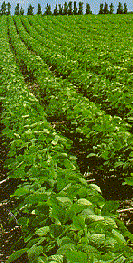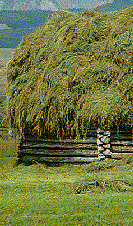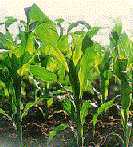Crop Rotation as a Form of Conservation
Voices from Knox County:



"Any university person will tell you that the best way to control weeds and
insects and disease is with a good crop rotation."
Crops need nutrients in order to grow. Grass plants--such as corn, wheat,
oats, and smelt--use nitrogen for growth. Legumes, such as soybeans and alfalfa
have a symbiotic relationship with nitrogen fixing bacteria in
the soil. Combined, bacteria and legumes create a form of nitrogen usable by
grass crops. As a result,
many farmers rotate between grass and legume crops thereby assuring a sufficient
level of nitrogen in the soil. Cover crops such as hay and clover
are also cycled into the rotation in order to add additional organic material
to the soil and increase the tilth of the soil. A few examples of rotations
used in the county are:
corn-soybeans-oats-clover hay
soybeans-corn-wheat
corn-soybeans
In addition to rotating crops, many farmers rotate their livestock among
different sections of pasture. This facilitates the dispersal of
manure in the
fields as well as prevents over-grazing of any one section. Overgrazing
of pasture can lead to a depletion of vegetation and consequent soil erosion.
One Knox County farmer explained that rotating livestock through different sections
of pasture was actually healthier for the cattle and more cost effective
for the farmer. The cattle benefit by eating the most nutritious grasses.
Meanwhile, the farmer does not have to purchase feed for the animals.
photo credits: Farm Journal (corn), Mid-Feb. 1994; Farm and Ranch Living (hay),
June/July 1992; Farm Journal (soybeans), Feb. 1994


 E-Mail The Family Farm Project
E-Mail The Family Farm Project





 E-Mail The Family Farm Project
E-Mail The Family Farm Project